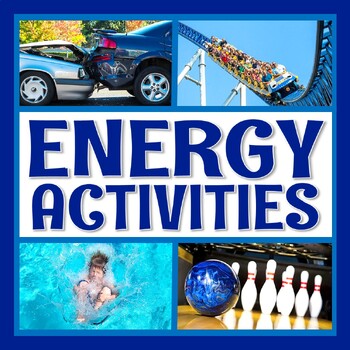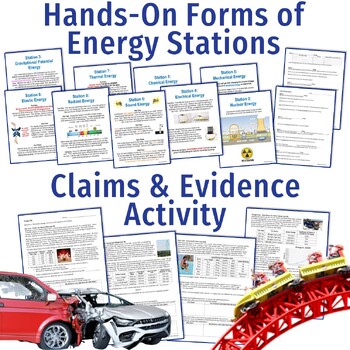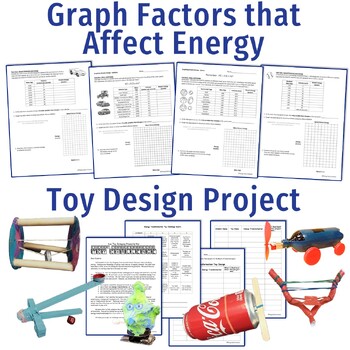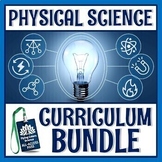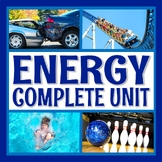NGSS Energy Activity BUNDLE
- Zip
- Easel Activity

What educators are saying
Products in this Bundle (6)
showing 1-5 of 6 products
Bonus
Also included in
- Never search for "something to do tomorrow" ever again! This bundle contains PRINT AND GO lessons, NO PREP activities, LOW PREP labs, and ENGAGING articles to supplement and thoroughly enhance a physical science course. Every included resource is easy to implement, standards-based, and high-quality.Price $399.99Original Price $671.34Save $271.35
- SAVE 50% on 3 weeks of lesson plans! This bundle includes every resource we use to teach forms of energy, energy transformations, the law of conservation of energy, and how different factors affect energy. All of the work has been done for you - from start to finish!This set of resources forms a CPrice $25.00Original Price $50.71Save $25.71
Description
SAVE 30% OFF list prices plus a FREE BONUS! Includes 6 NO or LOW PREP activities! Includes engaging activities, graphing practice, hands-on stations, a low-prep lab, and a fun project for energy transformations - all designed to SUPPLEMENT and add FUN to an existing energy unit!
This bundle includes the following:
- Hands-On Forms of Energy Stations (Free bonus!)
- Energy Transformations Matching
- Energy Claims and Evidence Activity
- Potential and Kinetic Energy Lab (Easy Supplies!)
- Graph How Mass and Speed Affect Kinetic Energy (2 versions to choose from!)
- Energy Transformation Toy Project
INDIVIDUAL DESCRIPTIONS:
1. Hands-On Energy Stations (FREE BONUS): Let kids experience each form of energy HANDS-ON! Includes 9 station cards, one for each form of energy. Each station has kids "play" with a form of energy (except nuclear - there's a reading for that). Each card has student directions on the front and materials required on the back. This resource also includes a student worksheet for students to complete as they move through the 9 stations. This activity requires quite a few supplies, so it is a Word document that you can edit to substitute with the supplies you have on hand.
2. Energy Transformations Activity: Effective for true comprehension, this activity is designed to help middle school students recognize the energy transformations that occur in the world around us. Students are given 30 colored picture cards of things like hairdryers and solar-powered cars and then complete a graphic organizer to record energy forms before and after. (Includes a Google Slides version, too!)
3. Energy Claims and Evidence Activity: Use REAL-LIFE examples to help students to make connections between the factors that affect potential energy (height and mass) and the factors that affect kinetic energy (mass and speed). Students read brief passages, make observations about simple data tables, answer questions, and make claims based on evidence about the factors that affect energy. (Includes a Google Slides version, too!)
4. Potential and Kinetic Energy Lab: Easy supplies - only tennis balls (link to cheap ones) and meter sticks are needed! This is a RIGOROUS and THOROUGH version of the popular bouncing balls potential and kinetic energy tennis ball lab. Over the years I have tried many versions, but I've never been happy with them. I've tweaked and added and honed them all into this streamlined lab activity. Three different sections explore (1) kinetic and potential energy, gravitational potential energy, and the law of conservation of energy (2) GPE and height, and (3) GPE and KE.
5. Graph How Speed & Mass Affect Kinetic Energy: (2 Versions to choose from!) This activity has middle school students calculate (simple math, middle school appropriate) and GRAPH how MASS and SPEED affect kinetic energy. Choose either data from different cars or data from different sports balls (or do both!). All data is based on realistic information about various types of cars, so this adds engagement for kids.
6. Energy Transformation Upcycled Toy Design Project: Challenge students to create a toy based on ENERGY TRANSFORMATIONS using upcycled or recycled materials. Clear, simple instructions lead to GREAT projects with students of diverse abilities! Students can use whatever they have at home to design their toy, so it doubles as an upcycling project, as well. This is a fun one, for sure!
Teacher Notes:
- These resources are not editable.
- Supports NGSS Standards: MS-PS3-1, MS-PS3-2, and MS-PS3-5
- An answer key is always included.
- If the resource has an option to assign in Google, a link is provided in the downloadable PDF.

